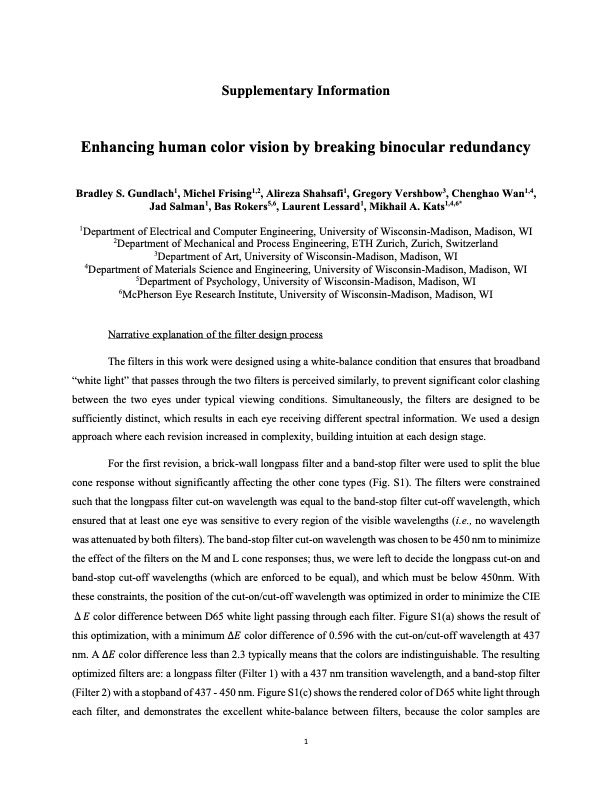
PDF Publication Title:
Text from PDF Page: 021
Supplementary Information Enhancing human color vision by breaking binocular redundancy Bradley S. Gundlach1, Michel Frising1,2, Alireza Shahsafi1, Gregory Vershbow3, Chenghao Wan1,4, Jad Salman1, Bas Rokers5,6, Laurent Lessard1, Mikhail A. Kats1,4,6* 1Department of Electrical and Computer Engineering, University of Wisconsin-Madison, Madison, WI 2Department of Mechanical and Process Engineering, ETH Zurich, Zurich, Switzerland 3Department of Art, University of Wisconsin-Madison, Madison, WI 4Department of Materials Science and Engineering, University of Wisconsin-Madison, Madison, WI 5Department of Psychology, University of Wisconsin-Madison, Madison, WI 6McPherson Eye Research Institute, University of Wisconsin-Madison, Madison, WI Narrative explanation of the filter design process The filters in this work were designed using a white-balance condition that ensures that broadband “white light” that passes through the two filters is perceived similarly, to prevent significant color clashing between the two eyes under typical viewing conditions. Simultaneously, the filters are designed to be sufficiently distinct, which results in each eye receiving different spectral information. We used a design approach where each revision increased in complexity, building intuition at each design stage. For the first revision, a brick-wall longpass filter and a band-stop filter were used to split the blue cone response without significantly affecting the other cone types (Fig. S1). The filters were constrained such that the longpass filter cut-on wavelength was equal to the band-stop filter cut-off wavelength, which ensured that at least one eye was sensitive to every region of the visible wavelengths (i.e., no wavelength was attenuated by both filters). The band-stop filter cut-on wavelength was chosen to be 450 nm to minimize the effect of the filters on the M and L cone responses; thus, we were left to decide the longpass cut-on and band-stop cut-off wavelengths (which are enforced to be equal), and which must be below 450nm. With these constraints, the position of the cut-on/cut-off wavelength was optimized in order to minimize the CIE Δ𝐸 color difference between D65 white light passing through each filter. Figure S1(a) shows the result of this optimization, with a minimum Δ𝐸 color difference of 0.596 with the cut-on/cut-off wavelength at 437 nm. A Δ𝐸 color difference less than 2.3 typically means that the colors are indistinguishable. The resulting optimized filters are: a longpass filter (Filter 1) with a 437 nm transition wavelength, and a band-stop filter (Filter 2) with a stopband of 437 - 450 nm. Figure S1(c) shows the rendered color of D65 white light through each filter, and demonstrates the excellent white-balance between filters, because the color samples are 1PDF Image | Enhancing color vision by breaking binocular redundancy

PDF Search Title:
Enhancing color vision by breaking binocular redundancyOriginal File Name Searched:
enhancing-human-color-vision-670-nm.pdfDIY PDF Search: Google It | Yahoo | Bing
Cruise Ship Reviews | Luxury Resort | Jet | Yacht | and Travel Tech More Info
Cruising Review Topics and Articles More Info
Software based on Filemaker for the travel industry More Info
The Burgenstock Resort: Reviews on CruisingReview website... More Info
Resort Reviews: World Class resorts... More Info
The Riffelalp Resort: Reviews on CruisingReview website... More Info
| CONTACT TEL: 608-238-6001 Email: greg@cruisingreview.com | RSS | AMP |